
Back to Blogs
Discover
Spooky Legends of Bury St Edmunds and Beyond
With a 1000 year history, Bury St Edmunds & Beyond is the setting for many a spooky Bury St Edmunds myth legend!
Magical creatures, ghostly beings, miracles and monsters - Bury St Edmunds and the surrounding Suffolk towns and villages have been the setting for many a myth and legend!
Saint Edmund and the Wolf
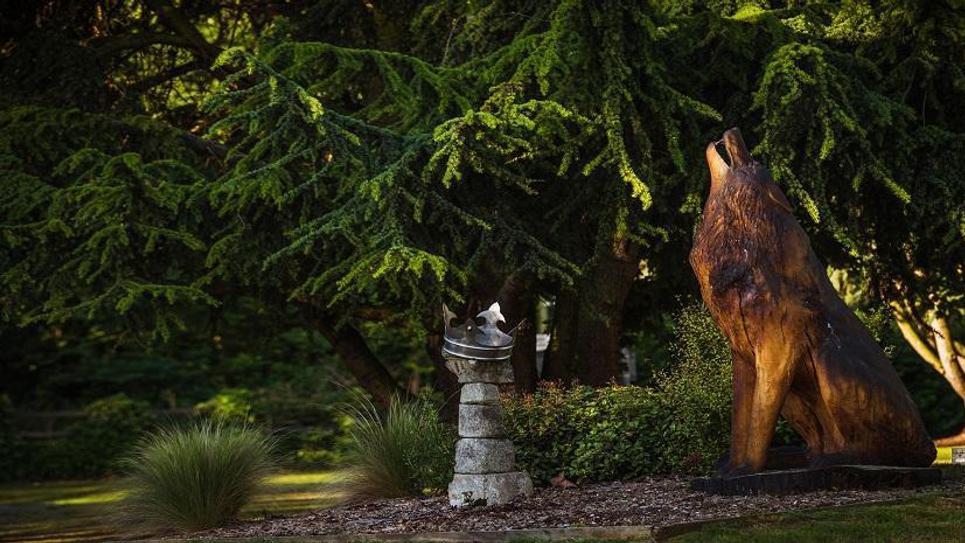
The story of St Edmund, who ruled East Anglia from AD 855 to 869, tells of the brave King Edmund who was killed by Danish invaders on 20 November 869 after refusing to renounce his Christianity.
A wolf is a central figure of his story. The story goes that after being tied to a tree and shot full of arrows he was then beheaded. When his body was found, the head was missing, thought to have been thrown into briars in the forest.
However, supporters of the King heard a wolf call to them and upon tracking it down, found it guarding the king's head. When the head was reunited with Edmund's body, the head and body miraculously fused back together. Thought to be a sign of his sainthood, many miracles were then attributed to Edmund and his shrine in Bury St Edmunds became a place of pilgrimage.
UFO over St Edmundsbury Cathedral
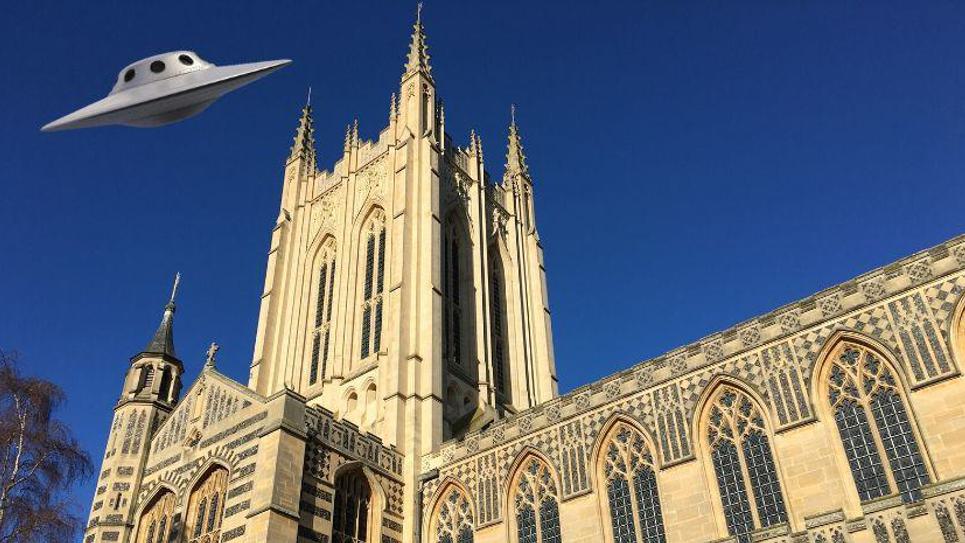
Myths and legends aren't always tales from years gone by. In 2008 if you'd have looked up into the winter's sky in Bury St Edmunds you may be forgiven for thinking Santa was on his way, or perhaps the lights that were spotted in the sky above St Edmundsbury Cathedral were something out of this world.
Around 10pm, a man reported to the police that he had seen an unusual object, grey in colour and spinning in the sky hovering above the cathedral. He claimed that it had been seen by four or five other people for around 10 minutes before it travelled round the cathedral and then disappeared.
The flying orange ball was then seen in the sky above Churchgate Street towards the churchyard! He then saw a bright orange ball flying through the sky from Churchgate Street towards the churchyard.
The Legend of Maude Carew
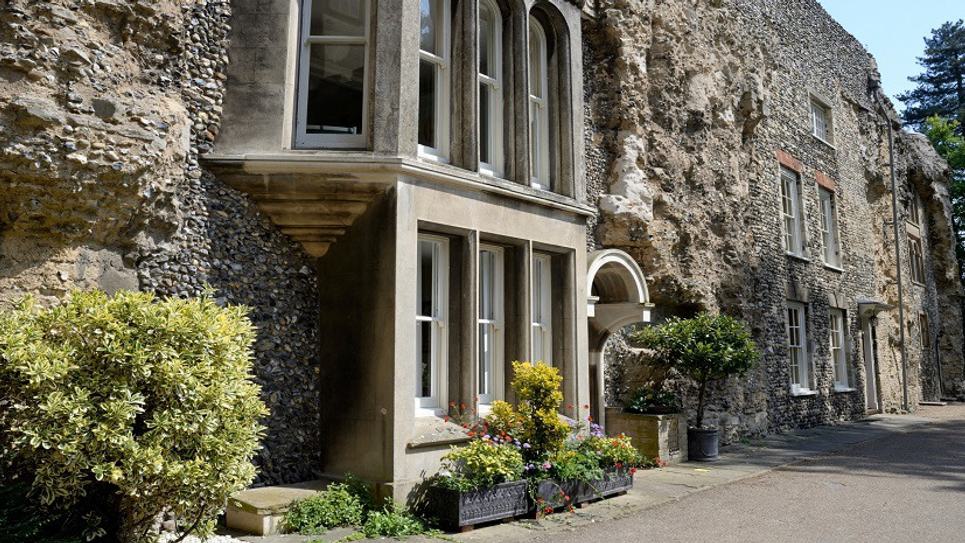
Margaretta Greene’s novel "The Secret Disclosed" is a local legend in the town, telling the tale of Maude Carew, a nun in medieval Bury St Edmunds whose unrequited love for a monk of the Abbey of St Edmund lead her to murder Humphrey Duke of Gloucester.
The ghost story sparked riots on the streets of Bury St Edmunds upon its release in 1860. Fictional and released on a limited run, Greene's family was thought to be the only intended readers, but as word-of-mouth spread, a large crowd gathered at the Great Churchyard in February 1862, expecting to see the ghost of Maude Carew - an event predicted in the book.
The Secret Disclosed was Greene’s only published work, but remains a legend in Bury St Edmunds with gatherings held at the Great Churchyard in February to this day. Greene lived all of her life in a house next to the St Edmundsbury Cathedral and is a member of the family which founded the Greene King brewery.
Historian Dr Francis Young has recently re-published the book The Secret Disclosed: A Legend of St Edmund's Abbey, adding his own introduction.
The Spider Invasion of Bury St Edmunds
The story of the spider invasion of Bury St Edmunds first appeared in Mirabilis Annus Secundus in 1662 and was part of a list of “strange signs and apparitions” meant to be warnings from God. which, it was said, were appearing as a warning to everyone to obey the word of God.
It is said that a swarm of spiders formed a parade, making their way to the home of Sir John Duncombe, a member of the late Parliament who had once been Chancellor of the Exchequer and later been knighted.“…As the people passed the street, or came near the spiders, to look upon so strange a sight, they would shun the people, and kept themselves together in a body till they came to the said Duncombe’s house, before whose door there are two great posts
“There they stalled, and many of them got under the door into the house, but the greatest part of them, climbing up the posts, spun a very great web presently from the one post to the other, and then wrapt themselves in it in two very great parcels that hung down near to the ground.”
Upon finding two huge spider webs filled with red marching spiders outside their master’s home, Sir Duncombe’s servants, destroyed the webs by setting them on fire, killing thousands of spiders outside the country home.
The Green Children of Woolpit

Sometime in the 12th century, two children with unusual skin colour reportedly appeared in the village of Woolpit. The children, brother and sister, looked normal except for the green colour of their skin. They spoke in an unknown language, and would only eat raw broad beans.
Eventually they learned to eat other food and lost their green pallor, but the boy was sickly and died soon after he and his sister were baptised. The girl adjusted to her new life, but she was considered to be "rather loose and wanton in her conduct". After she learned to speak English, the girl explained that she and her brother had come from Saint Martin's Land, a subterranean world, where it was always twilight, inhabited by green people and had wandered into the world of human being through underground tunnels.
You can find out all about the legend of The Green Children at Woolpit Museum.
The Rendlesham Forest UFO Incident
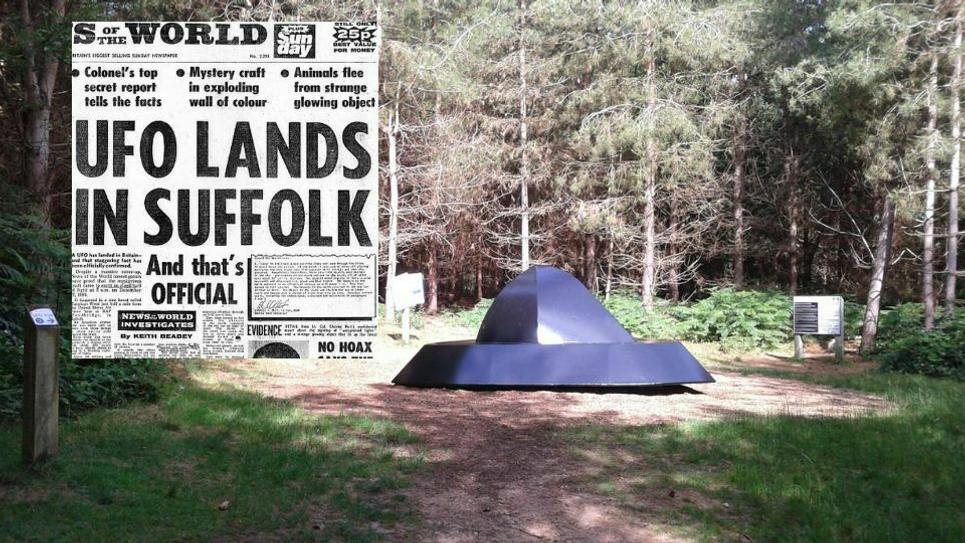
Often dubbed as the Roswell of the UK, the Rendlesham Forest UFO incident refers to several nights of strange UFO sightings and events in Rendlesham Forest in December 1980.
Witnessed by United States Air Force personnel based at RAF Woodbridge there have been many books and documentaries made on this spooky event just 40 miles from Bury St Edmunds.
You can learn more about this incident on the Rendlesham UFO Trail produced by Forestry England. A trail that will stimulate your imagination, taking you through forest, heathland and wetlands and some of the areas connected to the UFO event and see a model of the UFO that some witnesses say they encountered. Rendlesham is a delight to discover on bike, and provides a fantastic opportunity for natural cycling.
You can now scare yourselves silly at The Rendlesham Room in Bury St Edmunds, a brand new escape room inspired by on famous UFO "incident". Not for the faint hearted (or children) this room takes place in an eerie farmhouse where cultists have established contact with other worldly beings, for better... or worse.
The Brecks Bigfoot
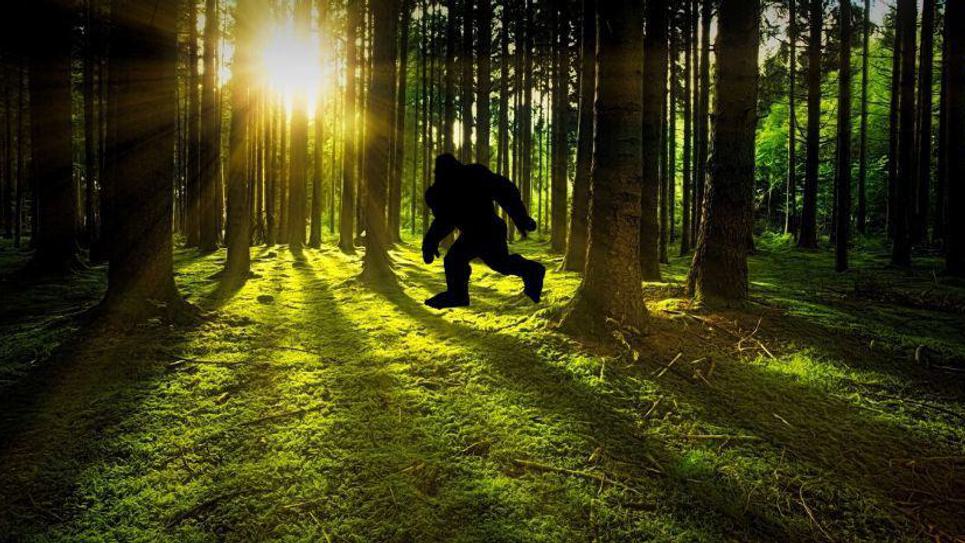
Lurking in the forest and heaths of Thetford and Brandon lives the Brecks Bigfoot; The month of June in 1986 was an unsettled month filled with electrical storms, unusual hail storms and fog-filled nights. It was on one of these nights that a long-haired creature with a light grey shaggy coat was spotted walking on four legs, but as the witness made their return journey, they saw the beast rise up on its hind legs like a human standing at eight feet tall.
Since 1986, there have been many sightings on the Brecks Bigfoot; witnesses speak of eye shine close to trees and low, throaty growls - dare you go down to the woods today?
Malekin of Dagworth
According to legend, a changeling is when a fairy child is left in a human child’s place while the human is whisked away to a different land. Dagworth Hall near Stowmarket has a colourful history, which can be traced back to the Domesday Book of 1086, was famous for being occupied by a magical, mischievous child who claimed to be human but who everyone believed to be a changeling.
Known as 'Malekin' he claimed not to be a changeling, but rather a human child who had been born in nearby Lavenham and stolen from a field from where his mother had been working. He said that he had been in his present form for seven years and that in a further seven years, he would be restored to living with people.
In the 1190s, the manor was home to a judge and knight called Osbert Fitzhervey, who lived there with his family. When Malekin first appeared at Dagworth, Osbert and his family were alarmed: they believed that an invisible, magical spirit had invaded their home and was playing pranks on them and whispering in a childish voice.
They quickly became enchanted with Malekin and began to share their secrets with him and leave food out on a special chest for him – he would wear special hats only once did he removing it to reveal himself to a maid.
An account of the strange visitation is given by Ralph of Coggeshall, a monk in the Cistercian abbey of Coggeshall in Essex, he wrote:
“In the time of King Richard [1189-99], there appeared frequently, and for a long space of time, in the house of Sir Osberni de Bradewelle, at Daghewurthe in Suffolk, a certain fantastical spirit who conversed with the family of the aforesaid knight, always imitating the voice of a one-year-old child.
“He called himself Malekin, and he said that his mother and brother dwelt in a neighbouring house, and that they often chided him because he left them and went to speak with people. The things which he did and said were both wonderful and very funny and he often told people’s secrets. At first the family of the knight were extremely terrified, but by degrees they became used to his words and silly actions, and conversed familiarly with him.”
The Magical Well of Woolpit
The village of Woolpit is also renowned for its spring of crystal-clear, pure water. Known as The Lady's Well, it has been a significant pilgrimage site for centuries. However, the most prominent attraction in the village was its church.
Prior to the Reformation, Woolpit's Chapel of the Blessed Virgin Mary, or Our Lady, with its revered Virgin known for performing miracles, stood as the religious epicenter of East Anglia. Adorned with riches of silver and gold, the chapel received countless gifts from grateful pilgrims, both wealthy and poor, who had been healed through prayer within its walls. Even royalty, such as Queen Elizabeth, wife of Henry VII, paid homage to the chapel during her visit in 1501.
Initially mentioned in mandates from the Bishop of Norwich dating back to 1211 and 1214, the chapel was eventually granted to the nearby monks of Bury Abbey. It remained a cherished place of worship for centuries, with records of numerous wills leaving legacies for the upkeep of its shrine. As early as the 13th century, the Feast of the Nativity of the Virgin Mary was established on 8th September, accompanied by a fair to accommodate and profit from the influx of pilgrims.
However, like many prominent shrines, it fell victim to the zeal of Henry VIII, who in around 1538 ordered the removal of its image. Subsequently, the surrounding chapel was dismantled around 1551. Following this, the site gradually faded into obscurity, and Woolpit receded to the margins of history. While archaeologists debate the precise location and finer details, it is believed to have resided on the north side of the church’s chancel.
The Magic Dell of Elveden

The story goes that one day in the 1800s, a young girl was walking along a road through the village of Elveden, passing a wood that bordered the road when she heard something that made her stop, listening carefully, she could hear the soud of music, chimes, tinkling and high-pitched laughter.
As the girl grew she would recall to people that the music she had heard that day was fairy music; a sound so bewitching that is was likely to snare passing horses and lure them down into the fairies’ magic dell.
The Bures Dragon

First recorded in 1405 by a local monk, the story of the Bures Dragon has been recounted many more times over the years. Taking place in Bures, the village where St Edmund was crowned King of England in 855, several townsfolk recall being terrified by a huge beast with a crested head, serrated teeth, and long tail. It terrorized the village, breathing fire and killing a shepherd and his flock.
The men of the fiefdom tried to kill the dragon with arrows, but failed to injure him, so men from across the country were summoned to slay the dragon, which fled down river toward the adjacent village of Wormingford and disappeared into the marshes, never to be seen again.
One account of the tale recalls the bowmen of Bures celebrating by heading to the pub for a meal of dragon-roasted sheep.
While the villagers of Bures may have been mistaken thinking the scaly creature was a dragon, it is thought that the scaly creature may have in fact been a crocodile that was given to King Richard I as a gift from King Saladin during the 12th-century Crusades. The reptile would have been kept at the Tower of London in the royal menagerie, but is believed to have escaped and ended up in the marshes near Bures.
The tale can been evidenced across Suffolk today, with several old churches in the area featuring depictions of dragons on their walls, including a 15th-century painting of the storied creature in the Wissington Church a few miles from Bures.
As part of the Queen's Golden Jubilee Celebrations in 2012, the legendary dragon was also etched onto a hill in the village, and whist it is located on private land it can been seen from a distance.
Related Posts


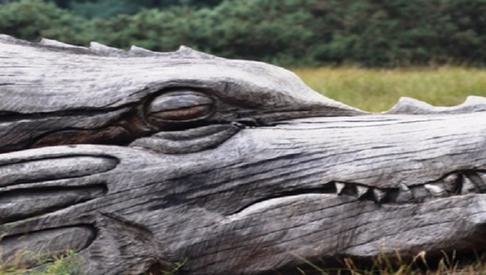
Discover the Beowulf and Grendel Adventure…
You can find the UK’s first permanent Beowulf and…
View More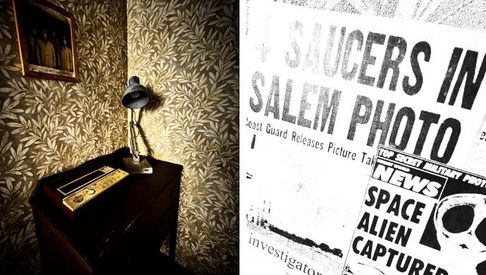
Related Blogs

News
Town’s Museum Forms New…
Moyse’s Hall Museum will be forging links with a…

News
Where to Go Pumpkin Picking…
Autumn fun, fresh air, and fields full of pumpkins in…

News
The Largest Witch Trial in…
The largest witch trial in English's history took…

News
The Bury St Edmunds Witch…
We speak to writer Tallulah Brown and Director Owen…

News
Internationally Renowned…
Internationally Renowned American Author Visits Bury…
Latest news

News
How to Spend Betwixtmas in Bury St Edmunds & Beyond
The post Christmas period is the perfect time to get out and about before the new year kicks in, and you’ll find plenty of activities and places to visit in Bury St Edmunds and beyond.

News
Parents Guide to Pre Christmas Entertainment
It's the school holidays and with Christmas just around the corner we've put toegther a guide on places to take the kids to keep them entertained until Santa visits!

News
Enjoy a Festive Afternoon Tea in 2025
Celebrate the Christmas season with a festive afternoon tea in Bury St Edmunds & Beyond...

News
Festive Winter Walks
Get outside and enjoy the fresh crisp winter air with one of these walks in Bury St Edmunds and Beyond!

News
Bury Tour Guides to launch new tours next year after successful 2025
Bury St Edmunds Tour Guides to Introduce new tours in 2026 and continue the successful Food and Drink Tours!

News
New in Bury St Edmunds For 2026
A sneak peak into new attractions visitors can enjoy in Bury St Edmunds in 2026.

News
Baby It's Cold Outside... Things To Do When the Weather Turns Frosty
Just because the temperature’s dropped doesn’t mean the fun has to! If you’re visiting town during the chillier months, there’s still plenty to see, do, and experience.

News
Places to sit by a roaring fire in Bury St Edmunds & Beyond
Warm up by a roaring fire this winter in Bury St Edmunds & Beyond...

News
Christmas Park and Walk 2025
Additional parking has been provided by West Suffolk Council in partnership with Greene King this Christmas.
